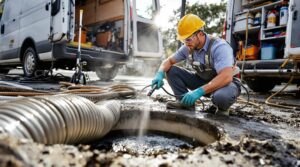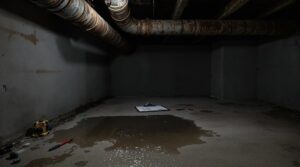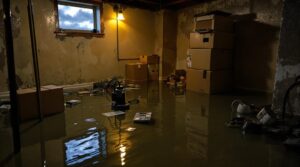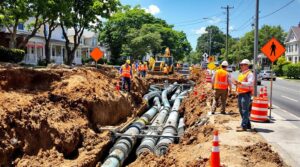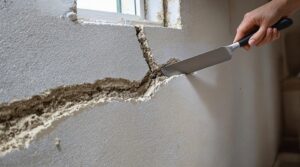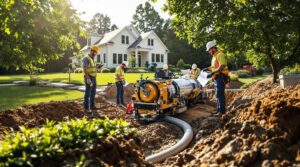Basement drain overflow commonly results from clogs, environmental factors, or infrastructure issues. Primary causes include debris blockages, heavy rainfall overwhelming municipal systems, and damaged underground pipes. Immediate responses should include shutting off electricity and water supply while wearing protective gear. Solutions range from regular maintenance and drain cleaning to installing backflow preventers and upgrading sump pumps. Professional assessment can reveal additional preventive measures and insurance considerations essential for long-term protection.
Key Takeaways
- Clogged drains from debris, grease, and hair restrict water flow, while faulty sump pumps fail to remove water effectively.
- Heavy rainfall and poor foundation grading lead to water accumulation and overwhelm drainage systems, causing basement overflow.
- Tree root infiltration and damaged underground pipes compromise drainage functionality and create blockages in sewer lines.
- Install backflow preventers, upgrade sump pumps, and improve landscaping to prevent future basement drain overflow issues.
- Regular maintenance, including drain trap cleaning and annual professional inspections, helps prevent drainage system failures.
Common Causes of Basement Drain Overflow
Basement drain overflows stem from several distinct causes that property owners must recognize to prevent potential flooding. When a clogged main drain occurs due to accumulated debris, grease, or hair, it greatly impairs the system's ability to manage water flow effectively.
Tree roots seeking moisture can infiltrate and damage underground pipes, leading to sewage backup and water backing into the basement.
Heavy rain events pose a particular challenge, as saturated ground and overwhelmed municipal systems create pressure that forces water back through household drains.
Additionally, broken pipes and deteriorating infrastructure, especially common in aging homes, compromise the drainage system's integrity.
Improper flushing habits, such as disposing of non-degradable materials like wipes and paper towels, create blockages that compound existing drainage issues. These blockages not only lead to inconvenient backups but can also cause damage to plumbing systems over time. Homeowners often find themselves facing costly repairs and the need for professional help when these issues escalate. To avoid such scenarios, it’s essential to understand toilet and shower clog solutions that can effectively address these problems before they worsen.
The problem can be further exacerbated by incorrect pipe installation or insufficient slope gradients, which prevent proper water flow and increase the likelihood of basement flooding.
Emergency Steps When Your Drain Backs Up
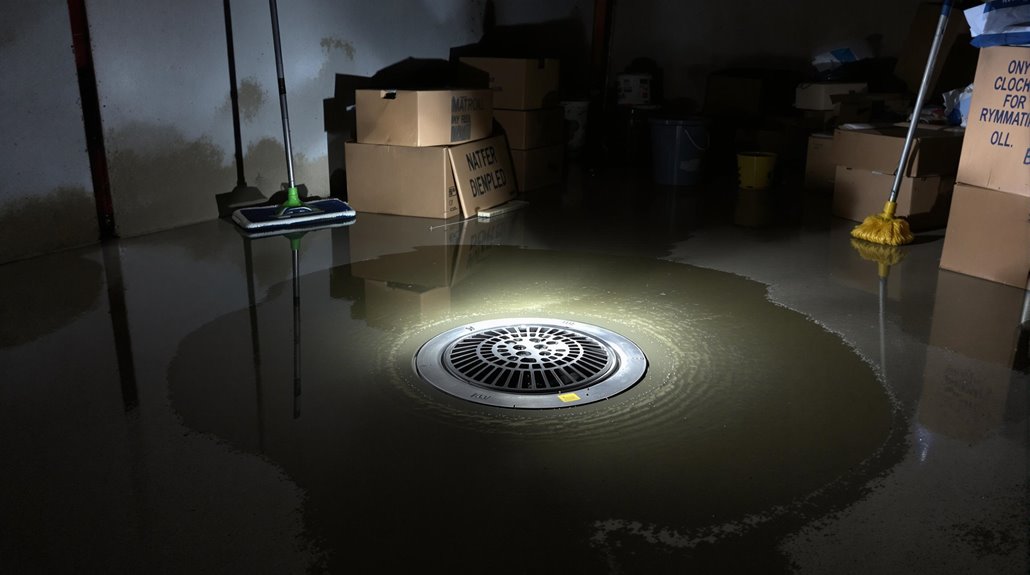
When a drain backup occurs, immediate action becomes crucial to minimize damage and protect occupants' safety. The first emergency steps involve shutting down potential hazards: turn off the electricity to prevent electrical hazards from standing water, and shut off the water supply at the main valve to stop additional inflow.
Due to the health risks associated with sewage backup, occupants should evacuate the affected area immediately. If entry into the flooded area becomes necessary, proper protective gear must be worn, including waterproof boots and facemasks.
To prevent further complications, residents should cease using all plumbing fixtures, including toilets and sinks, until the situation is resolved.
Professional assistance should be contacted promptly, as sewage backups often stem from complex common causes that require specialized equipment and expertise to address. A qualified professional can properly assess the situation, implement necessary repairs, and guarantee safe cleanup procedures are followed to restore the affected area.
Professional Vs DIY Solutions for Drain Backups
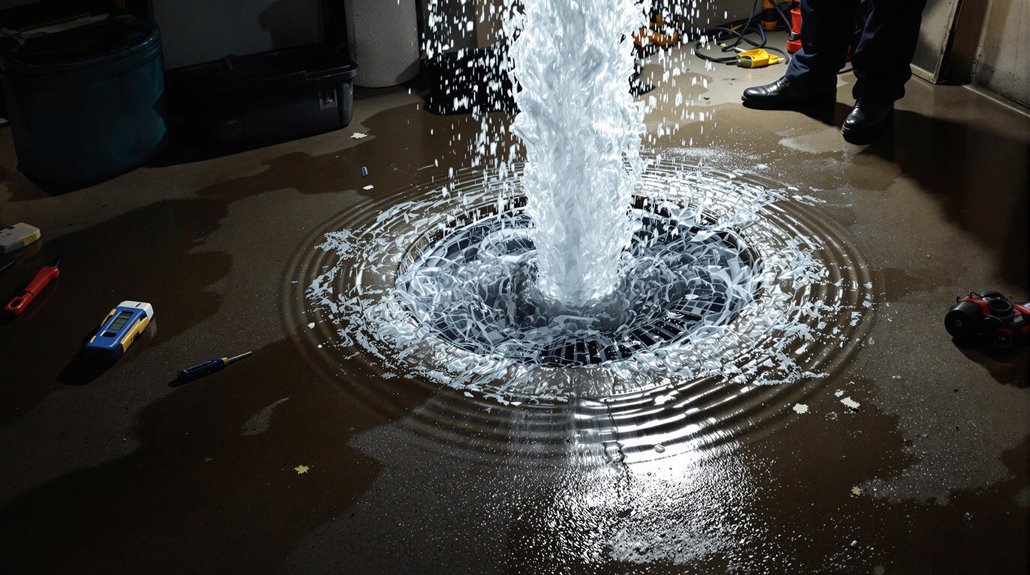
Deciding between professional intervention and DIY solutions for drain backups requires careful consideration of the problem's severity, available resources, and technical expertise.
Basic DIY solutions, including plungers, drain snakes, and natural cleaners, can effectively resolve minor clogged drains at minimal cost. However, these methods may prove inadequate for complex issues involving the main sewer line.
Professional plumbing services offer advanced diagnostic capabilities through sewer camera inspections and specialized treatments like hydro jetting, which can identify and clear blockages that DIY methods might miss.
While professional services typically cost between $200-$400, they provide extensive solutions for persistent backups and guarantee proper handling of complex plumbing systems.
Homeowners should evaluate their plumbing experience before attempting DIY repairs, as improper tool usage can damage pipes or worsen existing problems.
For recurring issues, investing in professional expertise guarantees thorough assessment and implementation of long-term solutions, preventing costly future repairs.
Preventive Maintenance to Avoid Future Overflow
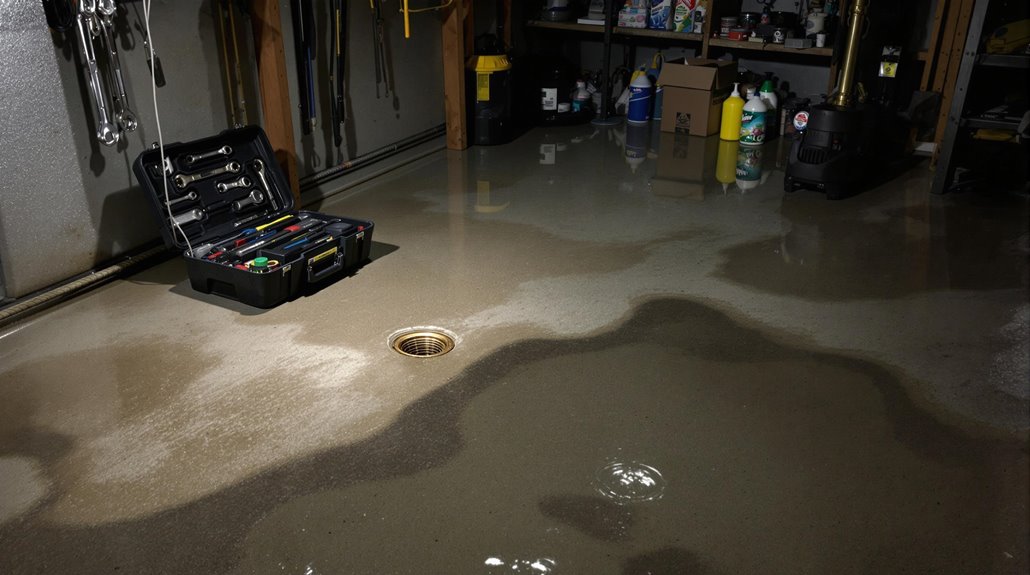
Implementing regular preventive maintenance protocols greatly reduces the risk of basement drain overflow and costly emergency repairs. Homeowners should establish an extensive maintenance schedule that includes regularly cleaning drain traps and installing screens or strainers on basement drains to prevent debris accumulation and potential clogs.
Annual inspections conducted by professional plumbers are vital to identify aging pipe issues and assess the overall condition of drainage systems. These inspections help prevent flooding by addressing minor problems before they escalate into major failures.
Additionally, maintaining a functional sump pump guarantees effective water management during heavy rainfall periods.
Proper household education regarding flushing practices plays an important role in preventing future overflow incidents. By implementing strict guidelines about what can and cannot enter the drainage system, homeowners can greatly reduce the likelihood of a clogged drain.
This preventive approach, combined with routine maintenance, creates a strong defense against basement flooding and drain backup issues.
Health and Safety Risks of Sewage Backups
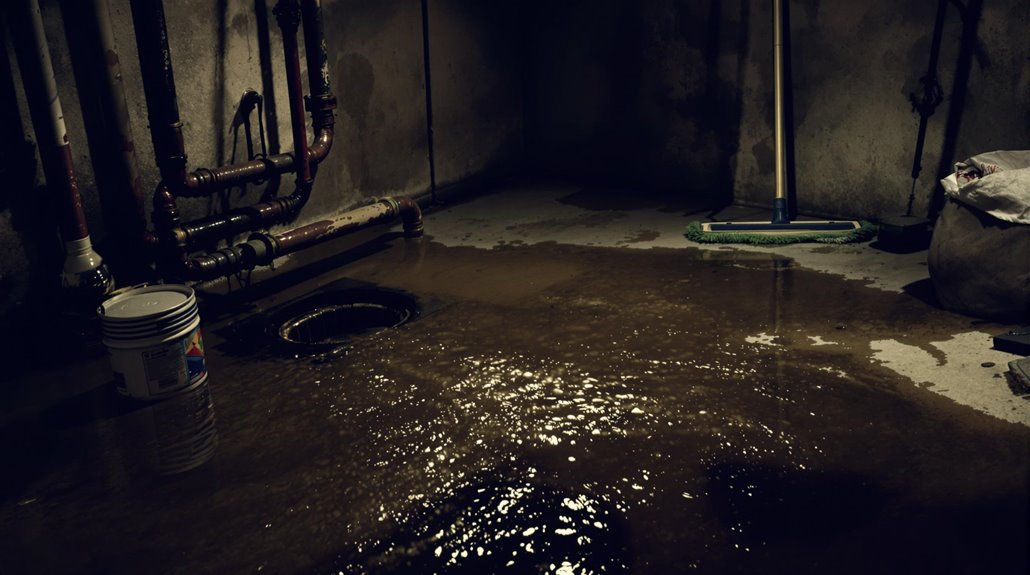
Sewage backups introduce severe health hazards into residential environments through exposure to dangerous pathogens, bacteria, and viruses. When contaminated water infiltrates living spaces, occupants face risks of respiratory issues, skin irritations, and gastrointestinal illnesses from direct contact or airborne particles.
These health risks are particularly pronounced for vulnerable populations, including children, elderly individuals, and those with compromised immune systems.
The presence of sewage creates conditions conducive to rapid mold growth, especially in poorly ventilated basement areas. This secondary contamination can trigger allergic reactions and exacerbate existing respiratory conditions.
To address these health risks, implementation of proper sanitation practices is crucial. This includes thorough cleaning and disinfecting of affected areas using appropriate protective equipment and EPA-approved disinfectants.
Professional intervention may be necessary for extensive contamination to guarantee complete remediation and prevent long-term health complications from exposure to sewage-related pathogens.
Cost Considerations for Drain Repair and Replacement

While immediate drain repair costs typically range from $200-$400 for basic unclogging services, extensive damage requiring pipe replacement can result in expenses reaching several thousand dollars.
Homeowners should evaluate their insurance coverage, as standard policies generally exclude sewer backup protection, necessitating additional specialized coverage for thorough protection against plumbing failures.
Regular maintenance and inspections represent a cost-effective strategy to prevent emergency repairs and minimize long-term expenses associated with basement drain issues.
Similar to flood damage exclusions, most standard homeowners insurance policies do not cover water damage from drainage system failures without additional coverage.
Immediate Vs Long-Term Expenses
Homeowners frequently face essential decisions when addressing basement drain overflow issues, balancing immediate repair costs against long-term maintenance expenses. While unclogging a basement floor drain might cost several hundred dollars initially, investing in routine cleaning and preventive maintenance can greatly reduce future repair costs. Hydro jetting, though more expensive upfront, offers lasting protection against recurring clogs.
| Service Type | Immediate Cost | Long-Term Value |
|---|---|---|
| Basic Unclog | $200-400 | 3-6 months |
| Hydro Jetting | $400-800 | 1-2 years |
| Pipe Replacement | $2000-5000+ | 25+ years |
| Regular Maintenance | $100-200/year | Ongoing protection |
Since homeowners insurance typically excludes sewer backups, preventive measures become vital for financial protection. The investment in routine cleaning and system assessment proves particularly valuable for properties with aging infrastructure.
Insurance Coverage Factors
Most standard insurance policies provide limited or no coverage for basement drain overflow incidents, making it vital for property owners to understand their coverage options and potential financial risks.
Typical homeowners insurance excludes sewage backups, requiring additional coverage to protect against potential damages and associated repair costs.
Insurance providers offer specialized sewer backup coverage as a supplemental option, which can help mitigate financial losses from damaged plumbing fixtures and extensive cleanup requirements.
Property owners should carefully review specific coverage limitations within their policies to guarantee adequate protection.
With repair costs ranging from $200 for basic unclogging to several thousand dollars for pipe replacement, securing appropriate insurance coverage is essential.
Understanding these insurance factors helps homeowners make informed decisions about protecting their investment against basement drain overflow incidents. By being aware of coverage options and potential risks, homeowners can tailor their insurance policies to better suit their needs. Additionally, in the unfortunate event of a basement drain overflow, having a plan in place is crucial, which is where flooded basement cleanup tips come into play. These tips not only help mitigate damage but also ensure a quicker recovery process, allowing homeowners to safeguard their property effectively.
Liability and medical coverage in a standard homeowners policy typically does not extend to damage caused by drain backups or flooding.
Municipal Sewer System Impact on Basement Drainage
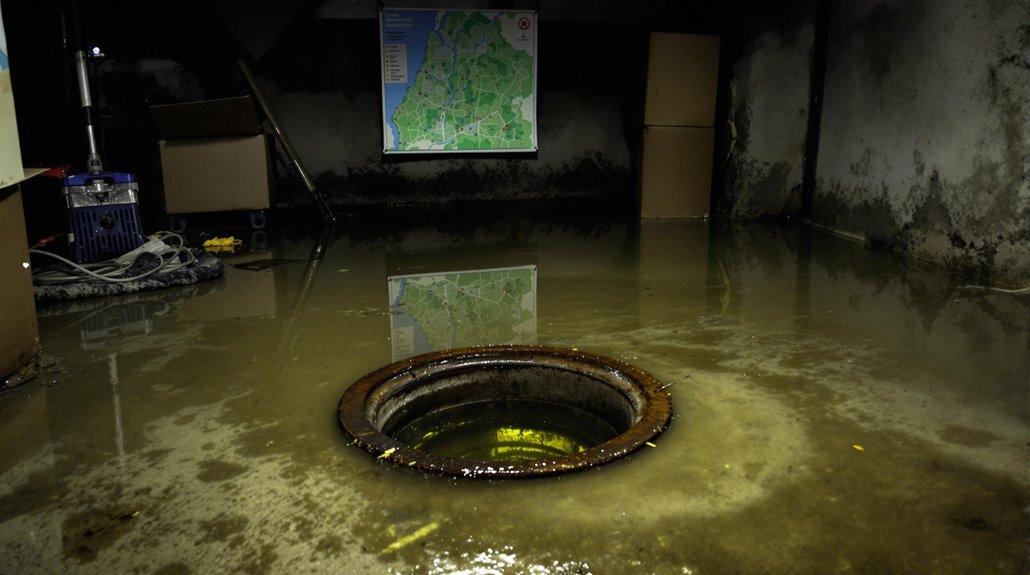
Municipal sewer systems play an essential role in basement drainage functionality, particularly during severe weather events.
During periods of heavy rainfall, these systems can become overwhelmed, leading to significant drain backups in residential properties. This is especially problematic in areas with combined sewer systems, where both sewage and stormwater share the same infrastructure.
Older municipal infrastructure and inadequate stormwater management systems are particularly vulnerable to overflow situations. When system capacity is exceeded, untreated sewage can reverse direction, flowing into basement drains and causing extensive damage to low-lying properties.
To address these challenges, many municipalities now require protective measures such as backwater valves or sump pumps in residential properties.
The relationship between municipal sewer capacity and basement flooding risk necessitates both systemic infrastructure improvements and individual property protection measures. Homeowners in areas served by aging or combined sewer systems should be particularly vigilant about implementing preventive solutions.
The Benefits Of Consulting A Public Adjuster
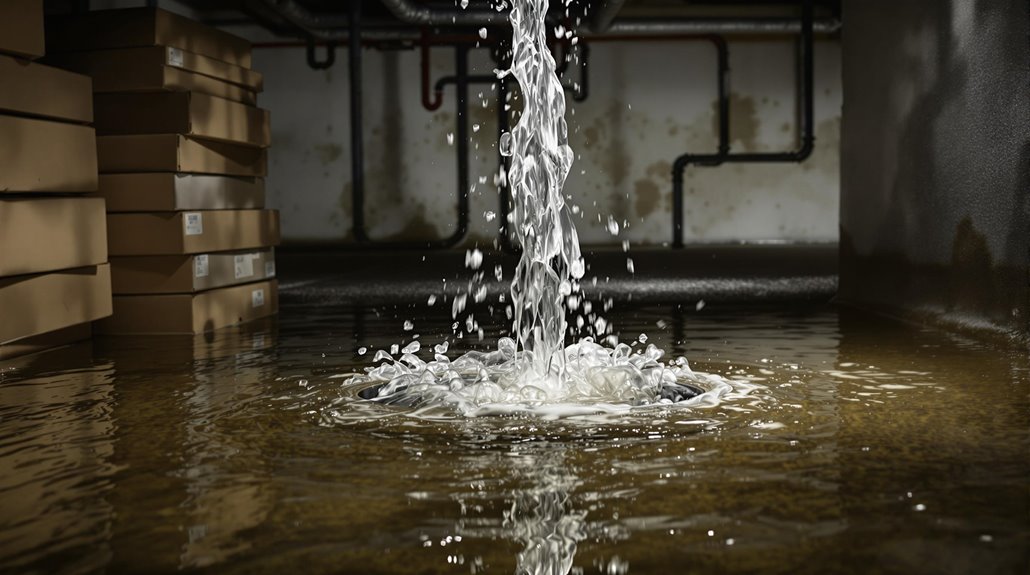
When dealing with basement flooding insurance claims, consulting a public adjuster provides critical advantages through their specialized expertise in policy interpretation and claim documentation.
Public adjusters conduct thorough, objective damage assessments while managing all aspects of the claim process, effectively streamlining communications with insurance carriers and documentation requirements.
Studies indicate that policyholders who engage public adjusters often secure notably higher settlements, with increases of up to 800% compared to self-managed claims.
Working on a contingency fee basis, public adjusters typically charge 5-20% of the final settlement amount, making their services accessible to homeowners facing significant basement damage.
Expertise In Insurance Claims
Dealing with basement drain overflow claims can be overwhelming for property owners, which makes consulting a public adjuster a valuable strategic decision.
These professionals possess specialized knowledge in handling complex insurance claims, ensuring thorough documentation and accurate valuation of damages.
Public adjusters bring expertise in identifying overlooked coverage options and hidden damages that homeowners might miss during initial assessments.
Their negotiation skills and experience with insurance companies typically result in higher settlement amounts.
Working on a contingency fee basis, they align their interests with the property owner's goals, making their services a strategic investment in the claims process.
Studies have shown that working with licensed public adjusters can increase claim settlements by up to 500% for non-catastrophic water damage incidents.
Objective Damage Assessment
Professional damage assessment through a public adjuster provides homeowners with a meticulous evaluation of basement drain overflow impacts. When facing a backup in your basement, these specialists conduct extensive inspections of water damage and potential structural issues that may affect the drain system.
Their expertise guarantees accurate documentation for insurance claims, leading to appropriate compensation for remediation efforts.
Key benefits of professional damage assessment include:
- Detailed evaluation of visible and hidden water damage, including potential mold growth
- Expert documentation of all affected areas, supporting maximum insurance coverage
- Technical analysis of structural impacts and necessary repairs
Public adjusters deliver objective assessments that strengthen insurance claims, helping homeowners receive fair settlements while eliminating uncertainties about the scope of damage.
This systematic approach guarantees no damage goes unnoticed during the claims process.
Working with independent claims adjusters can provide stronger advocacy for fair settlements, particularly in complex water damage scenarios.
Streamlined Claim Process
Through the expertise of public adjusters, homeowners can greatly expedite their insurance claims for basement drain overflow damage. Public adjusters not only assist in navigating the intricate claims process but also ensure that all potential damages are thoroughly documented and valued. They can provide invaluable insights into related issues, such as water heater flood causes and fixes, which may arise during the claim process. By leveraging their knowledge and experience, homeowners can achieve a more favorable settlement and restore their homes more efficiently.
These professionals understand the complexities of sewer system failures and their impact on property, guaranteeing thorough documentation of all affected areas. Their knowledge of insurance policies helps identify additional coverage options that property owners might otherwise miss.
Working on a contingency basis, public adjusters eliminate upfront costs while maximizing claim settlements through detailed assessments and skilled negotiations with insurance companies.
Their expertise in home automation systems and other modern installations guarantees accurate valuation of damaged components. By managing all aspects of the claims process, from initial documentation to final settlement, these specialists reduce the homeowner's stress and typically secure higher compensation.
Their understanding of local regulations and insurance practices proves invaluable in steering through complex claim scenarios effectively.
Higher Claim Payouts & Settlements
Statistical evidence demonstrates that engaging a public adjuster for basement drain overflow claims consistently yields higher settlement amounts. Studies show homeowners receive 20-40% larger payouts when utilizing professional claims assistance.
Public adjusters leverage their expertise in insurance policies and damage assessment to maximize compensation potential.
Key advantages of professional claim representation include:
- Thorough documentation and accurate damage assessment
- Expert interpretation of insurance policies and coverage benefits
- Strategic negotiation with insurance companies
The specialized knowledge public adjusters possess enables them to identify coverage details often overlooked by homeowners.
While their services involve a percentage-based fee, the investment typically results in higher settlements that offset the cost. Their ability to navigate the claims process professionally reduces stress while ensuring prime financial recovery for basement overflow damages.
About The Public Claims Adjusters Network (PCAN)
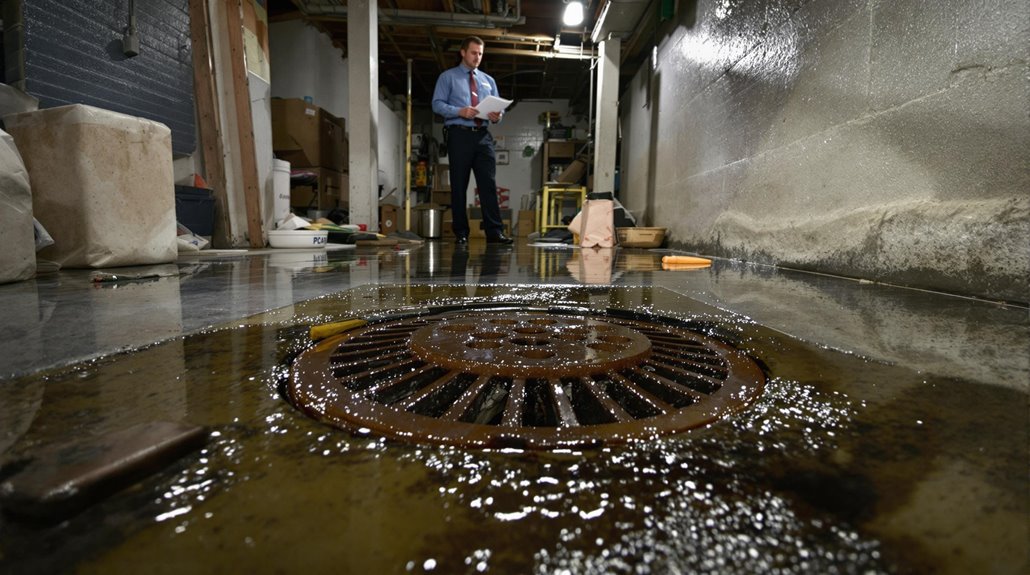
The Public Claims Adjusters Network (PCAN) operates as a nationwide alliance of verified, state-licensed public adjusters who handle residential and commercial property damage insurance claims.
With coverage across 40+ states and expertise in over 30 claim types, including water damage, sewage issues, and basement flooding, PCAN connects homeowners with elite insurance professionals.
PCAN maintains strict quality standards through a rigorous vetting process for all member adjusters.
Each professional must complete an intensive application and interview process before acceptance into the network.
To guarantee continued excellence, the organization conducts mandatory yearly audits of licenses and reviews any complaints against its members.
The network serves as an essential resource for property owners seeking expert assistance with insurance claims.
PCAN's member adjusters are selected for their demonstrated expertise, ethical standards, and track record of successful claim settlements, making them industry leaders in property damage assessment and policyholder representation.
Frequently Asked Questions
How Do I Stop Water From Coming up Through My Basement Floor Drain?
Effective waterproofing techniques include sump pump installation, drainage pipe maintenance, and overflow prevention systems to reduce hydrostatic pressure. Professional foundation repair and proper gutter maintenance prevent basement water infiltration.
Why Does My Basement Drain Keep Flooding?
Basement drain flooding typically occurs from inadequate drainage systems, heavy rainfall overwhelming sump pumps, foundation issues causing water accumulation, or insufficient plumbing maintenance. Professional basement waterproofing and drainage solutions may be necessary.
What to Do if the Sewer Backs up in the Basement?
First turn off electricity and water supply, then contact emergency plumbers. Install sump pumps, maintain drainage systems, and make certain of proper insurance coverage for future sewage backup prevention.
How Do You Unclog a Main Drain Line in a Basement?
For main drain clog removal, utilize a heavy-duty drain snake to break blockages. Professional hydro jetting offers thorough cleaning. Regular maintenance prevents future clogs. DIY solutions work for minor obstructions.
